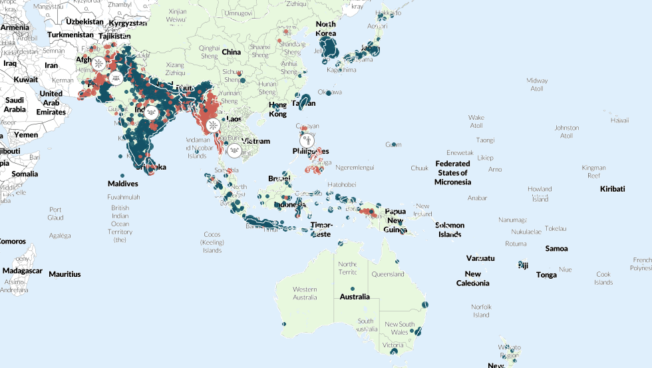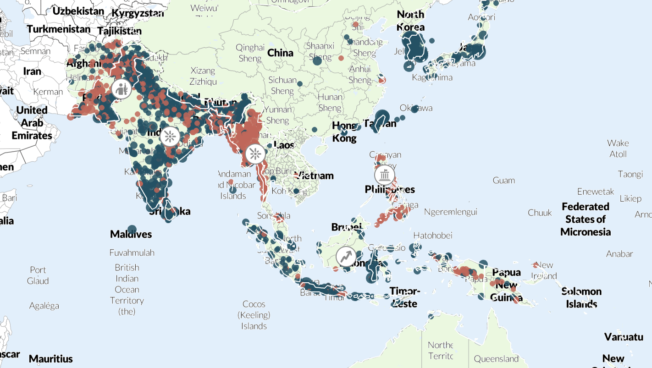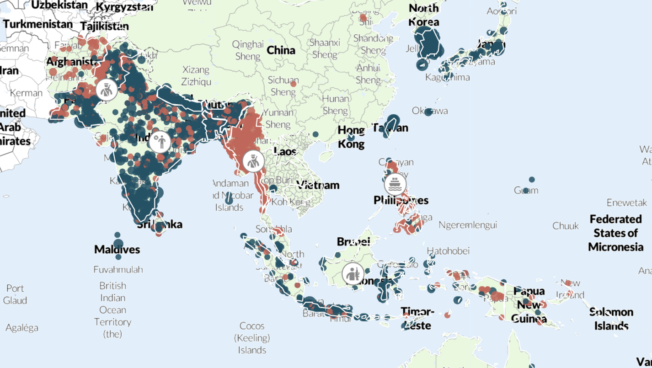Regional Overview
Asia-Pacific
May 2025
Posted: 9 May 2025
In this Regional Overview covering April 2025
- India: A deadly militant attack in Kashmir escalates tensions with Pakistan
- Indonesia: Rebels target miners in deadly attacks in Highland Papua
- Myanmar: The military increases offensives against the Ta’ang Army in northern Shan state
- Pakistan: Security forces crack down on militants in Khyber Pakhtunkhwa
- Philippines: Chinese, Philippine coast guards face off following Hegseth’s Manila visit
India: A deadly militant attack in Kashmir escalates tensions with Pakistan
On 22 April, separatist militants shot and killed at least 26 tourists, mostly Hindus, in the resort town of Pahalgam in the Kashmir Valley, in what was the deadliest attack on civilians in nearly two decades.1Shweta Sharma, “How Kashmir’s deadliest attack on civilians in years unfolded: ‘It was like a storm,’” The Independent, 23 April 2025 Initial reports attributed the attack to The Resistance Front (TRF), believed to be an offshoot of the Pakistan-based Lashkar-e-Taiba (LeT).2The Hindu, “The Resistance Front: The banned organisation behind Pahalgam terror attack,” 23 April 2025 However, TRF later denied involvement, stating their online platforms, where the attack was claimed, had been compromised.3The Economic Times, “‘False, hasty & part of an orchestrated campaign’: LeT terror proxy TRF backtracks; denies responsibility for Pahalgam attack,” 26 April 2025 Indian security forces are still searching for the perpetrators, some of whom were also reportedly involved in a deadly attack in the Ganderbal district last year, which was attributed to the TRF.4Mukesh Singh Sengar, “Terrorists Behind Pahalgam Attack Also Killed 6 Labourers, Doctor In 2024,” NDTV, 1 May 2025 According to ACLED data, TRF has been involved in at least 23 attacks targeting civilians, mainly non-Kashmiris and Hindus, since the group’s founding in 2019.
India accused Pakistan of orchestrating the attack and introduced a slew of diplomatic measures.5Abhishek Chakroborty, “India Suspends Indus Waters Treaty, Shuts Attari Border In Strong Response To Pakistan,” NDTV, 23 April 2025 For its part, the Pakistani government condemned the attack and called for an independent investigation.6Dawn, “Pakistan won’t initiate but will respond strongly to any Indian escalation: Dar,” 30 April 2025 Though neither side has formally reneged on the 2021 ceasefire agreement along the Line of Control (LoC) separating the Indian- and Pakistan-administered parts of Kashmir, ACLED records nightly cross-border exchanges between the two countries’ militaries since the attack. This comes on the back of ongoing tensions — even before the attack, more clashes had been recorded between India and Pakistan’s security forces in 2025 so far than in any single year since 2021.
The situation escalated on 7 May, as India carried out missile strikes targeting what it called “terrorist infrastructure,” including training camps and seminaries linked to the LeT and the Jaish-e-Mohammad, the group behind the 2019 Pulwama attack, at nine places within Pakistan-administered Kashmir and Pakistan.7Times of India, “Operation Sindoor: India targets Jaish-e-Mohammed and Lashkar-e-Taiba headquarters in Pakistan,” 7 May 2025 In response, Pakistan claimed to have shot down five Indian jets;8Reuters, “Three fighter jets crashed in India’s Jammu and Kashmir, local govt sources say,” 7 May 2025 India accepted at least three “crashes” and local media confirmed an additional crash.9Kamaldeep Singh Brar, “1 civilian dead, 9 injured as unidentified aircraft crashes in village near Bathinda Air Force base,” Indian Express, 7 May 2025 Cross-border clashes along the LoC, which had until now only involved small arms, subsequently intensified.10Basharat Masood, “Heavy shelling across LoC, J-K administration orders evacuation of residents from vulnerable areas,” Indian Express, 7 May 2025 With Pakistan reserving the right to respond, and the full impact of India’s strikes and the border clashes still emerging, the situation remains tense.
For more information, see ACLED’s Expert Comment: Kashmir attack stokes tensions along the India-Pakistan Line of Control.
Indonesia: Rebels target miners in deadly attacks in Highland Papua
In Highland Papua, the West Papua National Liberation Army (TPNPB) reportedly killed at least 23 gold miners during attacks in Yahukimo and Pegunungan Bintang regencies in April. The rebels shot dead a miner near the Kali Silet area on 6 April, while 22 others were killed in subsequent attacks between 6 and 10 April. Victims suffered gunshot wounds, machete slashes, and arrow injuries. Dozens of survivors were evacuated, at least eight miners went missing, and two were kidnapped. The TPNPB also burned down 10 mining camps during the month.11Tribunnews, “New terror by the Papuan criminal armed group after killing 16 miners: Burning ten camps in Mimika,” 24 April 2025 A TPNPB spokesperson claimed the victims were non-Indigenous Papuans engaged in illegal mining and accused them of being armed spies for Indonesian authorities — a claim denied by Indonesian armed forces.12Sapto Yunus, “Reasons why TPNPB-OPM justifies killing gold miners, non-Papuans in conflict zones,” Tempo, 12 April 2025
Mining remains a major source of conflict in Papua, a region that produces about 2% of the world’s gold.13PwC Indonesia, “Mining in Indonesia: Investment, Taxation and Regulatory Guide (14th Edition),” January 2025, p.14 The TPNPB has repeatedly demanded the cessation of mining activities. The group is believed to partly finance its activities through illegal mining in Intan Jaya, Paniai, Timika, and Yahukimo regencies. These latest incidents led to April becoming the deadliest month for mining worker victims of armed violence in Papua, accounting for over 40% of conflict-related fatalities in the region thus far this year.
Myanmar: The military increases offensives against the Ta’ang Army in northern Shan state
The Myanmar military intensified its offensive to regain territories captured by the Palaung State Liberation Front/Ta’ang National Liberation Army (PSLF/TNLA) in northern Shan State in April. On 1 April, the military conducted seven airstrikes in Nawnghkio township in a single day. The strikes came amid a one-month unilateral ceasefire announced by the Three Brotherhood Alliance — of which the PSLF/TNLA is a member — for relief efforts after an earthquake on 28 March. Although the military also declared a reciprocal ceasefire, effective from 2 to 30 April after an extension, it proceeded with more than 300 airstrikes across the country, including in areas controlled by the PSLF/TNLA in Mogoke and Nawnghkio townships. Fighting also broke out on the ground between the PSLF/TNLA and military columns advancing from Tawng Hkam and Ohn Ma Thee villages of Nawnghkio township throughout the month. The military was recently able to recapture Me Poke and Nawng Len villages, giving it an advantage to push further into PSLF/TNLA areas.
The military was able to relocate resources to its campaign against the PSLF/TNLA after the Myanmar National Truth and Justice Party/Myanmar National Democratic Alliance Army (MNTJP/MNDAA) withdrew from nearby Lashio town between 15 and 22 April as part of a ceasefire brokered by China. This military’s reestablishment of control in Lashio means a weakening of PSLF/TNLA positions in adjoining areas such as Hsipaw and Hseni. Clashes between the military and PSLF/TNLA are likely to increase, as recent talks brokered by China failed to result in a ceasefire or agreement.14Myanmar Now, “Chinese-brokered talks between Myanmar junta and Ta’ang army end in deadlock for second time,” 2 May 2025 The military demands that the PSLF/TNLA retreat from all their captured territories, which the PSLF/TNLA refuses to do.15RFA Burmese, “Myanmar’s Ta’ang army says it won’t give up territory despite junta, Chinese pressure,” 05 May 2025 The group claimed it would continue working with other resistance groups to fight against the junta.
Pakistan: Security forces crack down on militants in Khyber Pakhtunkhwa
Between 25 and 27 April, the Pakistani military reportedly killed at least 71 militants as they were attempting to infiltrate Khyber Pakhtunkhwa’s North Waziristan district from Afghanistan, the stronghold of the Tehreek-i-Taliban Pakistan – Hafiz Gul Bahadur (TTP-HGB). The army claimed that this was the highest-ever number of militants killed in a single engagement, though this has not been independently verified.16Dawn, “54 terrorists killed as infiltration attempt thwarted in KP: ISPR,” 27 April 2025 The newly formed Ittehad ul-Mujahideen Pakistan, an alliance of the TTP-HGB, Lashkar-e-Islam, and Harakat-e-Inqilab-e-Islami, confirmed the fatalities, which mark a crushing blow to the group only 10 days after its founding. The engagement followed the killing of a senior Tehreek-i-Taliban Pakistan (TTP) commander, marked as a potential successor for the leadership, during an operation on 10 April in Lower Dir district.17Haleem Asad, “Senior TTP commander killed in Dir action,” Dawn, 12 April 2025
These recent military successes may further push the militants to adopt less risky remote violence tactics, the use of which has increased since 14 March, when the TTP launched its Al-Khandaq spring offensive, deploying “targeted … and suicide attacks” against security forces, among other means.18X @khorasandiary, 14 March 2025 According to ACLED data, remote violence and violence targeting civilians by militants increased in Khyber Pakhtunkhwa in April compared to the month prior, even as direct clashes between the militants and security forces decreased.
Rising Islamist militancy in Khyber Pakhtunkhwa has strained Pakistan’s already tenuous relations with its neighbors. Pakistan implied that India is involved in the latest infiltration attempt in North Waziristan in a spillover of tensions between the two countries over Kashmir and has previously accused Afghanistan of harboring TTP militants.19Munir Ahmed, “Pakistani troops kill 54 militants attempting to sneak into Pakistan from Afghanistan,” The Independent, 27 April 2025 Between 11 and 12 April, the Pakistani military fired mortar shells across the Durand Line into Afghanistan’s Nuristan province, targeting TTP militants reportedly involved in a previous attack in Pakistan’s Chitral district, wounding two civilians. According to ACLED data, this was the first such Pakistani attack recorded in Nuristan province, an area that has historically had a strong TTP presence,20Sohail Chaudhry and Kamran Yousaf, “Operation Zarb-e-Azb: TTP sets up new sanctuaries in Afghanistan,” The Express Tribune, 26 October 2014 since February 2022.
Philippines: Chinese, Philippine coast guards face off following Hegseth’s Manila visit
Tensions between China and the Philippines rose anew in April as their militaries faced off in the disputed territorial waters of the South China Sea. On 6 April, a Philippine Coast Guard (PCG) vessel nearly collided with a China Coast Guard (CCG) vessel near Capones Island around the coast of Zambales, after both sides exchanged radio challenges. The next day, still off the coast of Zambales, a CCG vessel reportedly attempted to ram a PCG vessel, an act characterized by the Philippine side as a dangerous maneuver. The PCG alleged that the CCG has been deploying vessels off the coast of Zambales since January in an apparent attempt to “normalize” the presence of Chinese vessels there, though the PCG vowed to challenge this assertion.21Martin Sadongdong, “Chinese ship tries to ram PCG vessel repeatedly – official,” Manila Bulletin, 8 April 2025
The confrontations at sea came just days after United States Defense Secretary Pete Hegseth’s high-profile visit to Manila in late March, where he and his Philippine counterparts reaffirmed the US and the Philippines’ military alliance and stressed the importance of deterrence against Chinese threats.22Bea Cupin, “In Manila visit, Hegseth stresses deterrence ‘considering threats from communist Chinese,’” Rappler, 28 March 2025 China reacted negatively to Hegseth’s visit, seeing it as “aggravating regional tensions,” referencing the contested status not only of the South China Sea but also Taiwan.23Ma Bo and Lin Yu, “To China, Hegseth’s Philippines Trip Was an Escalation,” The Diplomat, 12 April 2025 On the heels of Hegseth’s visit, the Philippine military chief told the armed forces to prepare for the possibility of China’s invasion of Taiwan.24Raissa Robles, “Philippine military chief warns troops to ‘start planning’ in event of Taiwan conflict,” South China Morning Post, 1 April 2025; Joviland Rita, “Brawner to PH troops: Prepare in case of Taiwan invasion,” GMA News, 1 April 2025 Tensions between the Philippines and China continued to flare for the rest of the month. In mid-April, China released photographs showing the Chinese military raising the Chinese flag in Sandy Cay, another disputed part of the South China Sea. A few days later, Philippine soldiers returned the gesture and raised the Philippine flag in the same area. Both sides exchanged condemnations for the rival operations.
For more analysis on the Philippines, see ACLED’s latest report Clan violence in the Southern Philippines: Rido threatens elections and peace in Bangsamoro.
See More
See the Codebook and the User Guide for an overview of ACLED’s core methodology. For additional documentation, check the Knowledge Base. Region-specific methodology briefs can be accessed below.
Links:
- Methodology and Coding Decisions for Political Violence and Demonstrations in Afghanistan
- Methodology and Coding Decisions for Political Violence and Demonstrations in China and Taiwan
- Methodology and Coding Decisions for Political Violence and Demonstrations in Myanmar
- Methodology and Coding Decisions for Political Violence and Demonstrations in North Korea







